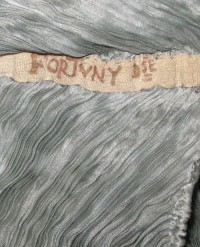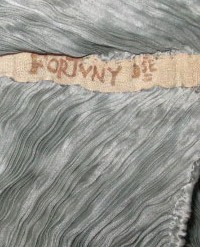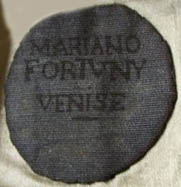Fortuny (Mariano Fortuny y Madrazo, 1871 – 1949) was, quite literally, born to his art. The son of a well known Spanish painter, he studied drawing, painting, and sculpture as well as chemistry and dyes. He moved to Venice at the turn of the century with his mother after his father died. In 1895 Fortuny met and fell in love with model Henriette Negin, whom he eventually married. They remained together until his death.
It was relatively late in life that Fortuny made his foray into the world of fashion when he presented his first design; a long sheer printed silk scarf he called the Knossos. In 1907 he devised his most famous Delphos gown. This was a revolution in fashion design and was eagerly accepted by those ready to give up the tortures of restrictive undergarments. The gown, fashioned from richly colored silks, was a simple free-flowing column with tiny mushroom pleating which created a long and slender appearance. The early gowns had batwing sleeves, later versions might be sleeveless, have a scarf attached at shoulders, or decorated with Venetian glass beads. Greek inspired and related to the “classical robe” is how Fortuny described his inspiration when he patented the design in 1909. He also made sheer printed tunics that were dyed to match and worn over the gowns. Each gown was one of a kind.
In 1919 Fortuny opened a factory for printing fabrics in Venice where he would develop printing techniques on velvets and cottons. He refined his silk dyeing process, often using metallics. He made fabrics for the home fashion industry such as lampshades and cushion covers. In addition to his work in fashion and textile design he was a photographer, award winning painter, sculptor and inventor.
Fortuny was a true visionary, his fabrics and designs are timeless works of art. Today his creations are rare and highly collectible.
Written by cactusandcattails




